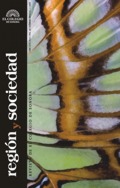 |
 |
 |
 |
 |
 |
 |
 |
 |
 |
 |
 |
Abstract
This article is a summary of the main results obtained in my doctoral thesis in the area of sociocultural epidemiology and within the Doctorate in Social Sciences Program at El Colegio de Sonora. This research was carried out by using two strategies: first, by analyzing the clinical records (a one-year census) in a local child care unit in order to know the epidemiological and clinical characteristics of epilepsy, and, second, six families living in the city's outskirts were interviewed with the aim to know, from their point of view, the main problems they have faced while caring for their children with epilepsy. Finally, a number of considerations and suggestions are made.
References
Andermann, Lisa Francesca. 2000. Epilepsy in Our World: An Ethnographic View. Epilepsy and Behavior 1 (3): 169–175.
Brailowsky Simón. 1999. Epilepsia. Enfermedad sagrada del cerebro. México: FCE. (Colección La Ciencia para Todos, núm. 170).
Cabrera, Mariana. 2006. Observaciones sobre la pobreza desde un enfoque de derechos humanos. En Social Watch. El derecho a no ser pobre. La pobreza como violación de los derechos humanos, coordinado por el Equipo de Investigación de Social Watch. Montevideo: Sociedad Bervejillo. (Serie de Cuadernos Ocasionales).
Clandinin, D. Jean y Michael F. Connelly. 2000. Narrative Inquiry: Experience and Story in Qualitative Research. San Francisco: The Jossey–Bass.
Commission on Social Determinants of Health. 2005. Action on the Social Determinants of Health: Learning from Previous Experiences. Ginebra: World Health Organization. http://www.who.int/spcial_determinats/en/ (7 de septiembre de 2007).
Consejo Nacional de Población. 2006. Índices de marginación. México: Consejo Nacional de Población.
Cummins, Steven, Sarah Curtis y Ana M. Rally. 2007. Understanding and Representing "Place" in Health Research: A Relational Approach. Social Science and Medicine 65: 1825–1838.
Finkler, Kaja. 1997. Gender, Domestic Violence and Sickness in Mexico. Social Science and Medicine 45 (8): 1147–1160.
García, Delia Esperanza. 2007. Mujeres pobres jefas del hogar en México. www.globaljusticecenter.org/ponencias2005/garcia_vences_esp.htm (6 de septiembre de 2007).
García Pedroza, Felipe. 1997. La epilepsia como problema de salud pública. En Epilepsia. Aspectos neurobiológicos, médicos y sociales, editado por Alfredo Feria Velasco, Dalila Martínez de Muñoz y Francisco Rubio Donnadieu. México: Ediciones del Instituto Nacional de Neurología y Neurocirugía.
González, S., J. Quintana y R. Fabelo. 1999. Epilepsia y sociedad: Una mirada hacia el siglo XXI. Revista Electrónica de Psiquiatría 3 (3). http://www.file://C/DOCUME1HU (6 de agosto de 2007).
Gracia, F. 1993. Epidemiología de la epilepsia en Latinoamérica. Foro de epilepsia. http://www:neurologia-rediris.es/congreso-1/conferencias/epilepsia-1 (18 de agosto de 2007)
Hersch Martínez, Paul y Jesús Armando Haro Encinas. 2007. ¿Epidemiología sociocultural o antropología médica? Algunos ejes para un debate transdisciplinar. Etnografías y técnicas cualitativas en investigación sociosanitaria. Un debate pendiente. Ponencia presentada en el VII Coloquio REDAM/Universitat Rovira I Virgil, Tarragona.
Instituto Nacional de Estadística, Geografía e Informática (INEGI). 2000. Información digital. Hermosillo. www.inegi.gob.mx (24 de julio de 2007).
Kaztman, Rubén. 2001. Seducidos y abandonados: El aislamiento social de los pobres urbanos. Revista de la CEPAL diciembre (75): 171–189.
Kleinman, A. 1995. Writing at the Margin. Discourse between Anthropology and Medicine. Berkeley: University of California Press.
Laurell, Asa. 2007. Health System Reform in Mexico: A Critical Review. International Journal of Health Services 37 (3): 515–535.
Lieblich, Amia, Rivka Tuval Mashiach y Tamar Zilber. 1998. Narrative Research: Reading,Analysis, and Interpretation. Thousands Oaks: Sage Publications.
Navarro, Vicente. 2007a. What is a National Health Policy? International Journal of Health Services 37 (1): 1–4.
––––––––––. 2007b. Neoliberalism as a Class Ideology; or the Political Causes of Growth of Inequalities. International Journal of Health Services 31 (1): 47–62.
Pérez Jáuregui, María Isabel. 2001. El síndrome de burnout ("quemarse" en el trabajo) en los profesionales de salud. Psicología y Psicopedagogía 2 (5). http://www.salvador.edu.ar/ua1-9pub02-5-02.htm (12 de septiembre de 2007).
Petchesky, Rosalind y Rosalind Judd (compiladoras). 2006. Cómo negocian las mujeres sus derechos en el mundo. Una intersección entre culturas, política y religiones. México: El Colegio de México.
Raphael, Dennis. 2006. Social Determinants of Health: Present Status, Unanswered Questions, and Future Directions. International Journal of Health Services 36 (4): 651–677.
––––––––––. 2003. Barriers to Addressing the Societal Determinants of Health: Public Health Units and Poverty in Ontario, Canada. Health Promotion International 18 (4): 397–405.
Robles, Leticia. 2002. Del amor al trabajo. La invisibilidad del cuidado a los enfermos crónicos. Tesis para optar por el grado de Doctora en Ciencias Sociales, Guadalajara, Universidad de Guadalajara–CIESAS Occidente.
Sistema para la Consulta de Información Censal (SCINCE). 2000. Sonora. XII Censo General de Población y Vivienda 2000. México: Instituto Nacional de Estadística, Geografía e Informática. www.inegi.gob.mx
Open access policy
The authors who publish in región y sociedad accept the following conditions:
In accordance with the copyright laws, región y sociedad recognizes and respects the authors’ moral rights, as well as the ownership of property rights, which will be transferred to the journal to disseminate the articles in open access. región y sociedad does not charge the authors for submitting and processing articles for publication.
All the texts published by región y sociedad —with no exception— are distributed under a Creative Commons license 4.0 Attribution – Noncommercial (CC BY-NC 4.0 International), which allows third parties to use the publication as long as they mention the works’ authorship and the first publication in this journal.
The authors can enter into independent and additional contractual agreements for the nonexclusive distribution of the version of the article published in región y sociedad (for instance include it into an institutional repository or publish it in a book) as long as they clearly indicate that the work was published for the first time in región y sociedad.
For all the above, the author(s) must send the Letter of transfer of property rights of the first publication duly filled in and signed by the author(s). This letter can be sent by e-mail as a PDF to: region@colson.edu.mx






